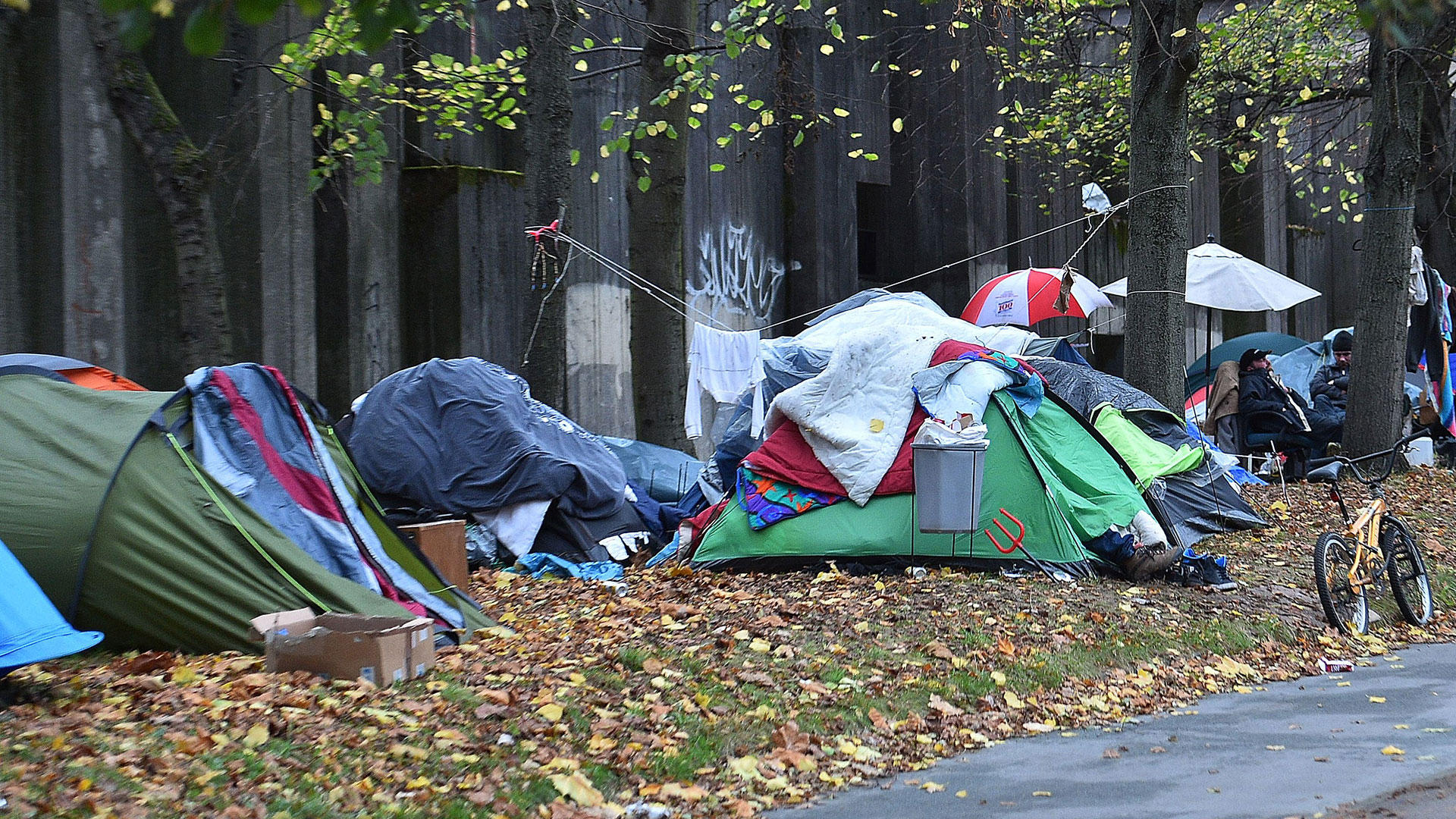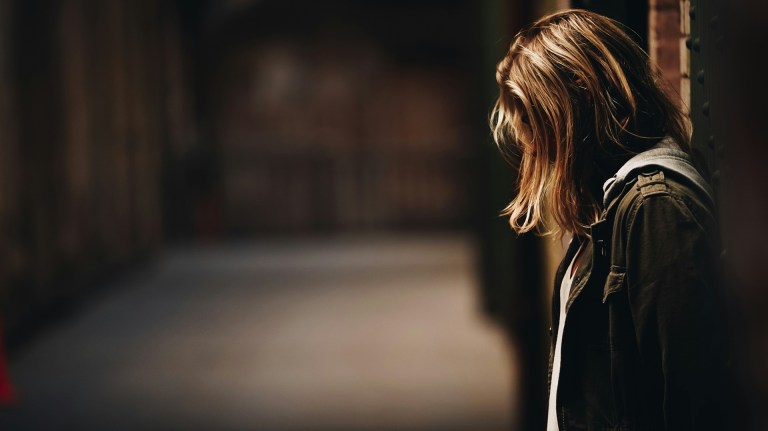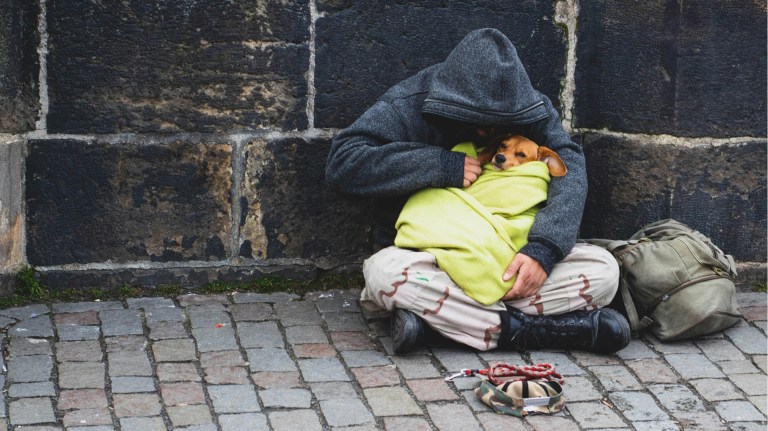Meanwhile, London mayor Sadiq Khan promised to end rough sleeping in the city by 2030 before his re-election.
But before you can tackle a problem, you must first learn the scale of the issue. That’s why it is vital that we know the facts and figures about homelessness. Here are the numbers you need to know:
How many people are homeless in the UK? How does the UK compare to other countries?
Homelessness in England, Scotland and Wales (as well as Northern Ireland) is typically measured separately but recent analysis by the FT found that one in every 200 households in the UK is experiencing homelessness.
That means the UK does not fare well against other developed countries.
John Glenton, executive director of care and support at Riverside housing association, said: “Shamefully, the UK tops the global league table with by far the highest rate of homelessness in the developed world with one in 200 households living in emergency temporary housing.
“It is now crucial to focus on solutions and work with the government to end this national scandal and international embarrassment.”
Advertising helps fund Big Issue’s mission to end poverty
How many people are homeless in England?
The latest official statistics show 358,370 households contacted their local authority for support after being threatened with homelessness or losing their home in 2023-24, up more than 10% in a year. Of these, 324,990 were assessed as homeless.
Record numbers of households are living in temporary accommodation in England. A total of 123,100 households were living in temporary accommodation in June 2024 – a record-high and 16.3% higher than a year ago.
The number of households with children in temporary accommodation rose annually by 15.1% to 78,420. The total number of children living in temporary accommodation has now reached 159,830.
Dr Laura Neilson, the chief executive of Shared Health Foundation – a charity supporting families in temporary accommodation – said: “It should be shameful that more than 159,000 children will be living in temporary accommodation. It should be a national conversation, an embarrassment the government tackles head on with urgency. Yet it remains a fringe conversation.”
Shelter analysis found 354,000 people were experiencing homelessness in England in 2024, including 161,500. That included 16,600 single people living in hostels or other homeless accommodation.
Overall, an additional 44,500 people were experiencing homelessness in England in 2024 compared to the year before.
Advertising helps fund Big Issue’s mission to end poverty
The official rough sleeping snapshot revealed 4,667 people were homeless on England’s streets in autumn 2024 based on single-night counts and estimates by frontline workers and local authorities.
That figure represents a 20% increase in just a year and is just 2% lower than the 2017 peak when 4,751 were recorded as sleeping rough. It’s also 164% higher than in 2010 when the count began.
The London-only Combined Homelessness and Information Network (Chain) figures are considered to be more accurate than the official one-night count.
The most recent annual count showed 11,993 rough sleepers spotted on London’s streets between April 2023 and March 2024. That’s a 19% increase on the previous year’s total and 58% higher than a decade ago.
In Janurary 2025, a quarterly count showed an 5% increase between numbers recorded through October to December 2024 when compared to the same period in 2023.
How many people are homeless in Wales?
The most recent statistics showed more than 13,000 households were assessed as homeless last year by councils, an increase of 8% on the year before.
Advertising helps fund Big Issue’s mission to end poverty
The number of households living in temporary accommodation is at its highest point on record, rising 18% in just one year to reach 6,447 households as of 31 March 2024.
The Welsh government published a white paper outlining a plan to end homelessness in 2023.
Andrew Connell, policy manager for The Salvation Army, said: “It’s disappointing to see the number of people who are experiencing homelessness in Wales going up again. The Welsh Government’s white paper is a step in the right direction. However, both the Westminster and devolved governments must address the shortage of affordable housing stock, especially social housing.
“As one the UK’s largest providers of support to people who are experiencing homelessness, we would also like to see more done to prevent homelessness repeating. That includes removing barriers to finding work and accommodation such as being unable to access a bank account due to not having an address. Poor financial stability is a major barrier preventing people rebuilding their lives.”
An estimated 192 people were sleeping rough in Wales as of July 2024.
How many people are homeless in Scotland?
The most recent annual statistics found there were 40,685 homelessness applications to local authorities in 2023-24, up 4% in a year and reaching the highest point since 2011-12.
Advertising helps fund Big Issue’s mission to end poverty
There were 33,619 households assessed as homeless or threatened with losing their home.
A total of 16,634 households were living in temporary accommodation as of September 2024. There were 10,360 children in temporary accommodation compared to 9,855 a year earlier.
The Scottish government has declared a housing emergency in the country.
Scotland doesn’t use the same method of counting rough sleeping as England and Wales. Rather than counts and estimates, statisticians rely on reports to local authorities.
The number of households that reported sleeping rough the night before applying to local authorities for support increased by 32% between April to September 2024 with 2,220 applications.
Maeve McGoldrick, head of policy and communications for Crisis in Scotland, said: “None of these figures will come as a surprise to anyone working in homelessness services. As the cost of living crisis continues to impact household incomes, more people being forced from their homes, often in circumstances where we know it could have been prevented from happening. That means more children forced to grow up without a safe, secure place to live and more money being spent on emergency responses, while the key causes of homelessness go unresolved.
Advertising helps fund Big Issue’s mission to end poverty
“These figures show councils are working to help move people out of homelessness and into settled accommodation, but they can’t keep up with growing demand for their help. That has led to growing numbers of people sleeping on the street, more people placed in accommodation that is totally unsuitable for their needs, and more instances of councils failing to meet legal obligations to people forced into homelessness.”
How many women are sleeping rough in the UK?
Women are often missing from rough sleeping counts because they tend to be less visible than male rough sleepers due to the risk of violence on the streets. That means women are more likely to seek shelter in cafes, transport hubs or other places rather than bedding down outside.
A coalition of homelessness and women’s organisations in London joined forces to tackle the issue in October 2022. Their first national census across England found the number of people sleeping rough could be as much as nine times higher than the official rough sleeping count.
In the 41 areas covered in the census, frontline teams found 816 female rough sleepers compared to just 189 covered in the official count.
Experts believe as many as 5,000 women could be missing from official rough sleeping counts in England.
How does homelessness affect health?
Three quarters of people experiencing homelessness quizzed in a 2014 Homeless Link survey reported a physical health problem.
Advertising helps fund Big Issue’s mission to end poverty
Meanwhile, 80% of respondents reported some form of mental health issue, while 45% had been officially diagnosed with a condition
Around 40% said they take drugs or are recovering from a drug problem, while 27% have or are recovering from an alcohol problem.
A total of 35% had been to A&E and 26% had been admitted to hospital in the six months before they took part in the survey.
What do people think about homelessness?
Four out of five Brits think that homelessness is a serious problem, according to an Ipsos poll for the Centre for Homelessness Impact at the end of 2024.
The poll, which quizzed 2,142 people on their views on homelessness, found 70% of those surveyed agreed that homelessness doesn’t get enough attention in society.
Most people – around two-thirds – believe that homelessness will increase in the UK over the next 12 months while barely a quarter think homelessness can be ended and twice as many think homelessness is inevitable.
Advertising helps fund Big Issue’s mission to end poverty
But 79% of Brits told pollsters that identifying people who might be at risk of homelessness earlier, such as in health and education, would make a difference.
Ligia Teixeira, chief executive of the Centre for Homelessness Impact, said: “These survey results highlight the pressing need for bold, preventative action to address homelessness. With over half the public supporting investment in prevention and 75% calling for affordable housing and stronger government guarantees, the message is unmistakable: prevention and structural solutions must take centre stage if we’re to break the cycle of homelessness for good.
“While the numbers reveal the scale of the challenge, they also reflect a shared belief in the power of prevention and systemic change. This is a call to action for all of us – government, communities, and individuals – to work together to ensure everyone has access to a safe, stable home.”
A further Ipsos poll from St Mungo’s found more than half of Brits believe there will always be significant levels of homelessness in the UK.
Pollsters found that the main reason people have not given their support to others facing homelessness came down to a lack of cash, food or clothes to donate. That was the case for 29% of adults, while 23% said there is no point in supporting people experiencing homelessness because they feel it won’t make a difference.
St Mungo’s urged people to donate to a homelessness organisation, volunteer or campaign around social issues to help people into longer-term accommodation.
Advertising helps fund Big Issue’s mission to end poverty
The poll found just 3% of those surveyed volunteered at local shelters or food banks in the last 12 months while 2% said they had advocated for policy change to prevent homelessness.
What is hidden homelessness?
Hidden homelessness is the term used to describe people who do not have a permanent home and instead stay with friends or family.
Also known as sofa surfing, many people in this situation may not consider themselves homeless and may not seek support from services. This makes it difficult to know exactly how many people are homeless, especially as they are not on the streets like rough sleepers and, therefore, not visible to frontline homelessness outreach workers.
Homelessness charity Crisis has estimated that as many as 62% of single homeless people do not show up on official figures and run the risk of slipping through the cracks.
The Office for National Statistics carried out a review into the scale of hidden homelessness across the UK in March 2023 but statisticians noted that the available information means “it is not currently possible to estimate the true scale of hidden homelessness across the UK”.
However, the review showed that hidden homelessness could take many forms: whether it be sofa surfing, living in unconventional structures like mobile homes or outbuildings, squatting or overcrowded accommodation.
Advertising helps fund Big Issue’s mission to end poverty
The review also showed that women, young people and ethnic minority groups are more likely to find themselves affected by hidden homelessness.
How do most people who are homeless die?
Nearly one in three people die from treatable conditions, according to a 2019 University College London study. Researchers warned that more preventative work was needed to protect physical health and long-term condition management, especially for more common conditions such as cardiovascular disease.
Homeless deaths have only been counted in recent years. The Bureau of Investigative Journalism’s pioneering Dying Homeless project counted the deaths of 796 people in 18 months before handing over the project to the Museum of Homelessness in March 2019.
MOH’s count recorded more than 1,400 deaths across the UK in 2023 – that represented a representing a 12% increase on 2022.
“People are dying on the street at terrifying rates,” warned MoH co-director Matt Turtle. “The only way to tackle this emergency is with an increase in support for off the street accommodation, like winter shelters.
“The systems of care for people living with poverty and homelessness are in tatters after 15 years of cuts and corruption. Labour has not yet set out plans to mitigate the damage caused by the last government and our analysis indicates things are set to get much grimmer unless the government acts now to save lives.”
Advertising helps fund Big Issue’s mission to end poverty
MOH used a combination of freedom of information requests, local news reports and submissions from the public to produce a count covering all kinds of homelessness, ranging from rough sleeping to people living in hostels and temporary accommodation. That method differs from the official counts where death certificates are analysed for signs a person died without a stable home.
The first official Office for National Statistics figures for England and Wales arrived three months before the end of TBIJ’s project, reporting 597 estimated deaths in 2017. The most recent count reported 688 people died without a secure home in 2020 with Covid accounting for just 13 deaths.
The ONS consulted on plans to discontinue homeless deaths statistics in early 2024 – citing concerns over accuracy – but ultimately U-turned following calls for the figures to remain.
The first-ever official homeless deaths count in Scotland arrived in 2020 using a similar methodology to the ONS.
The National Records of Scotland’s latest count found an estimated 242 homeless deaths in Scotland in 2023 – down by just two deaths on the previous year.
Crisis chief executive Matt Downie said: “These figures should represent a wake-up call for politicians of every party. Behind every one of these figures is a real person –someone robbed of their potential. These people formed a part of our communities and they will be missed.
Advertising helps fund Big Issue’s mission to end poverty
“Yet, the sad truth is that in many cases, these deaths will have been avoidable. Each year, more people are forced into homelessness, often trapped for long periods in emergency accommodation. We know how much damage that can do to your health.
“But it doesn’t need to be this way. We urgently need the Scottish government and opposition to press on with plans to prevent homelessness from happening in the first place.”
How can we end homelessness?
Homelessness is a complex issue and, as a result, there is no one-size-fits-all solution.
It takes effort to remove the reason why someone is homeless and also treatment for the trauma and mental toll of homelessness.
More broadly, there also needs to be efforts to address the systemic drivers of homelessness and that also takes political will to focus the sufficient resources in the areas where they will make a difference.
Homelessness experts, charities and organisations propose plenty of changes to how society operates to end homelessness for good. That includes tackling drivers of homelessness evictions from private rental homes, benefits that don’t keep pace with inflation and unaffordable housing. Other solutions, like Housing First, are aimed at helping people off the streets.
Advertising helps fund Big Issue’s mission to end poverty
You can keep the pressure on the politicians too by writing to your local MP, AM or MSP urging them to keep ending homelessness top of the agenda in parliament.
You can also give your time or money to volunteer and donate to help homeless charities doing vital work to help and house people affected by homelessness. There are tons of ways to help a homeless person, even just by donating your coat to help out in winter – cold temperatures are particularly dangerous for rough sleepers.
If you see a person experiencing homelessness on the street in England and Wales, you can contact Streetlink to connect them with support services.
And, of course, you can buy or subscribe to The Big Issue magazine to help us support vendors all over the UK, giving them the means to lift themselves out of poverty.
Big Issue Group is also going beyond the magazine in its mission of Changing Lives Through Enterprise. Find out more here.
Do you have a story to tell or opinions to share about this? Get in touch and tell us more. Big Issue exists to give homeless and marginalised people the opportunity to earn an income. To support our work buy a copy of the magazine or get the app from the App Store or Google Play.
Advertising helps fund Big Issue’s mission to end poverty










